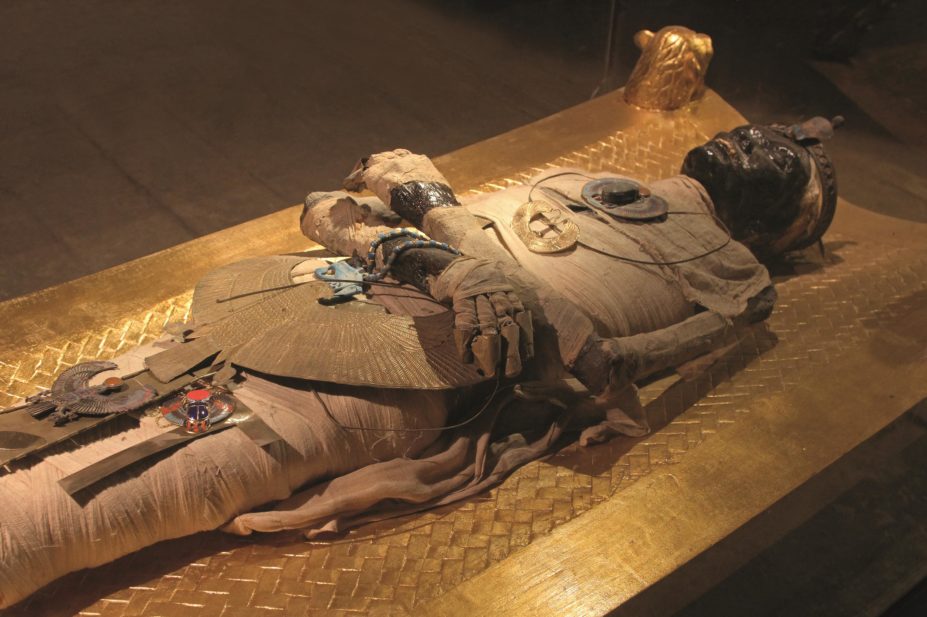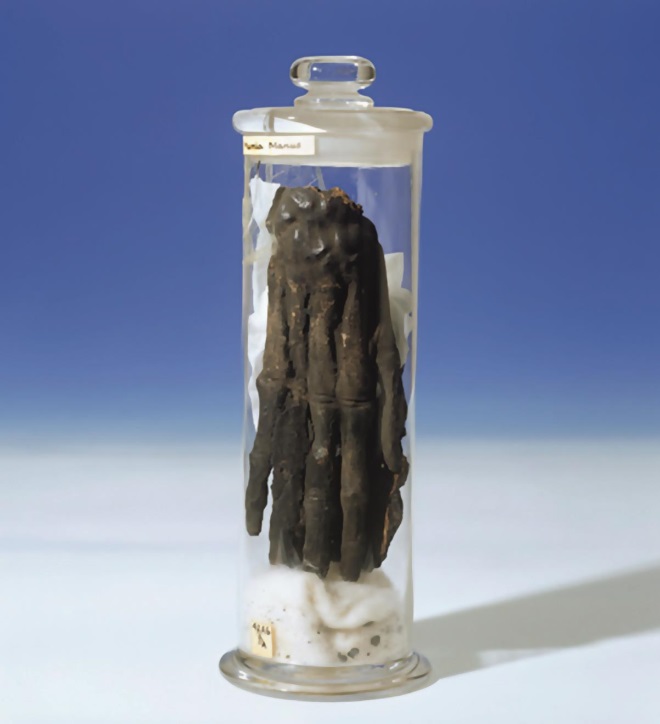
Ttatty / Shutterstock.com
It is not known who first introduced mummy as a medicine. Avicenna mentions its use in the treatment of paralysis, skin eruptions, abscesses and disorders of the liver and spleen. The medicinal properties were said to have been those of bitumen obtained from the Dead Sea. It is now believed that bitumen was not used in the mummification process and that the so called mummies used in medicine were, in fact, forgeries.

Source: Museum of the Royal Pharmaceutical Society
The hand of a mummy in the Royal Pharmaceutical Society museum.
In 1564, Guy de la Fontaine, physician to the King of Navare, visited Egypt to investigate sources and supply of mummies. He visited a Jew in Alexandria who showed him his stock of about forty mummies and who admitted that he had collected the bodies of slaves and other people which he opened and filled with bitumen. He then bandaged them and dried them in the sun until they assumed the appearance of true Egyptian mummies.
Pierre Pomet, author of ‘A compleat history of druggs’ (1712), wrote: “Of the mummies employed in medicine, five kinds were known:
1) The true Egyptian.
2) Factitious, or those in which bitumen and pitch were used in the process of embalming.
3) The Arabian, bodies embalmed with myrrh, aloes and other aromatic gums.
4) Bodies dried in the sun in the country of the Hammonians, between Cyrene and Alexandria, being mostly the bodies of passengers buried in the quicksands.
5) Artificial mummies.”
Preparations of mummy
Powdered Mummy
Given in doses of 2 drachms for epilepsy, vertigo and palsy. It was also applied externally to wounds to prevent mortification.
Tincture or Extract of Mummy
Salmon gives two versions. Querceran’s Extract is takes Arabian (Egyptian) Mummy in pieces and soak it in wine or turpentine. The liquid is reduced to the consistency of honey. Crollius’ version takes artificial mummy and makes the extract in wine.
“It is a counter-poyson, prevents the Plague, and resists all manner of Infection being taken only to one scruple, and cure being taken 20 one drachm or one and a half drachms.”
Treacle of Mummy
Crollius’ formula. Tincture of Mummy half a pound, Venice Treacle four ounces, salt of Pearl and Coral two drachms of each, Terra Sigillata two ounces, Musk one drachm. Mix and digest them in a gentle heat for a month.
Elixir of Mummy
Salmon’s formula. “Artificial Mummy cut small to which put Spirit of Turpentine, putrifie it forty days in a Vessel close luted: strain it, and put it into a Bladder with Spirit of Wine, digest, and in an Alembic in sand draw off the Quintessence with the spirit, which separate; the feces (sic) reverberate, and sublime to a salt, which unite with the separated Quintessence by circulation: then digest this Quintessence with Treacle and Musk to an Elixir.
It has all the vertues of the Tincture, besides which this is more speedy in the cure of the plague”.
Balsam of Mummy
Salmon’s formula. “Artificial Mummy cut small, digest it forty days with Oyl Olive in a luted Vessel; put it in a glass Body, and in B.M. let the foetid scent exhale, till the Mummy is dissolved, digest it twenty days more with S.V. (spirit of wine, i.e. alcohol) which separate, and you have a sweet-scented red oyl. This Oyl is exalted by digestion with S.V. and drawing it off four or five times.
…..it has such a piercing quality, that it pierces all parts, restores wasted limbs, consumptions, Hectics, and cures all Ulcers and Corruptions if four, five or six grains be given twice every day in a proper vehicle.”
According to Bechler in his Parnassus Medicinalis, 1663, “Mummy dissolves coagulated blood, relieves cough and pain in the spleen, and is very beneficial in flatulency and delayed menstruation.”
So for any of number of afflictions the answer could be “call for mummy”.
You may also be interested in

Calling the shots: the pharmacists combatting vaccine misinformation

Embedding quality improvement in pharmacy practice: a departmental strategy at University Hospitals of Derby and Burton
